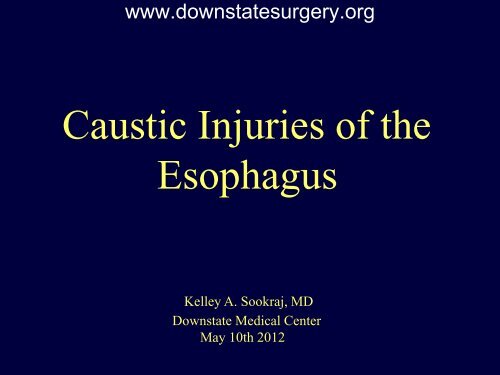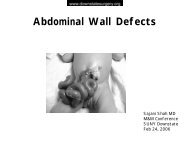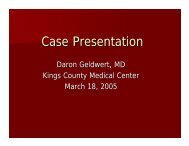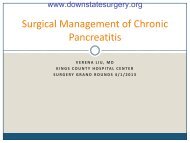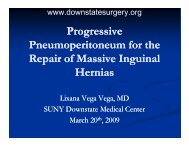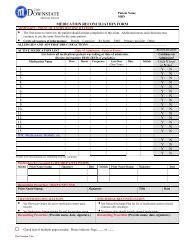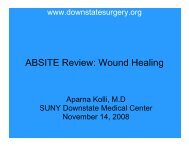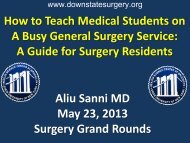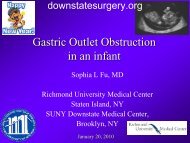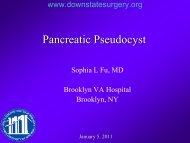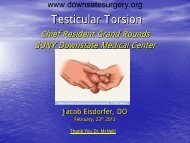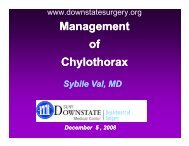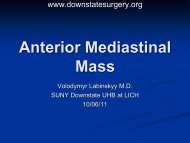Caustic Injuries of the Esophagus - Department of Surgery at SUNY ...
Caustic Injuries of the Esophagus - Department of Surgery at SUNY ...
Caustic Injuries of the Esophagus - Department of Surgery at SUNY ...
You also want an ePaper? Increase the reach of your titles
YUMPU automatically turns print PDFs into web optimized ePapers that Google loves.
www.downst<strong>at</strong>esurgery.org<br />
<strong>Caustic</strong> <strong>Injuries</strong> <strong>of</strong> <strong>the</strong><br />
<strong>Esophagus</strong><br />
Kelley A. Sookraj, MD<br />
Downst<strong>at</strong>e Medical Center<br />
May 10th 2012
www.downst<strong>at</strong>esurgery.org<br />
Case Present<strong>at</strong>ion<br />
• CC: esophageal stricture<br />
• HPI: This is a 31 y/o male who <strong>at</strong> age 16 ingested lye<br />
and underwent an esophagectomy with colonic<br />
interposition. He subsequently developed a stricture <strong>at</strong><br />
<strong>the</strong> proximal anastomosis which led to intermittent<br />
difficulty toler<strong>at</strong>ing a diet. He has had multiple<br />
dil<strong>at</strong><strong>at</strong>ions since his initial oper<strong>at</strong>ion (last 12/2011) and<br />
has now been referred for surgical evalu<strong>at</strong>ion and<br />
possible intervention.
www.downst<strong>at</strong>esurgery.org<br />
• PMHx: gastric ulcer<strong>at</strong>ions<br />
• PSHx: esophagectomy with colonic interposition,<br />
PEG (1997), esophageal dil<strong>at</strong><strong>at</strong>ions (1997 - 2011)<br />
• Allergies: Penicillin<br />
• Meds: lansoprazole<br />
• SHx: denies smoking, IVDA, occasional ETOH<br />
• FHx: non-contributory
www.downst<strong>at</strong>esurgery.org<br />
• Radiologic Studies: pre-op<br />
CT Neck/Chest/Abd/Pelvis: s/p esophagectomy<br />
with colonic interposition, proximal<br />
anastomosis visualized without evidence <strong>of</strong><br />
leak.<br />
Esophagogram: tight smooth stricture<br />
approxim<strong>at</strong>ely 2mm in diameter and 1cm in<br />
length <strong>at</strong> <strong>the</strong> proximal anastomosis
www.downst<strong>at</strong>esurgery.org<br />
• Vitals: Temp 98.5 F BP 120/75 HR 96 RR 18<br />
• Physical Exam:<br />
General: AAOx3<br />
HEENT: left neck scar<br />
Chest: equal air entry bil<strong>at</strong>erally<br />
CVS: S1S2, rrr<br />
Abdomen: midline scar well healed<br />
LE: no edema
www.downst<strong>at</strong>esurgery.org<br />
• Labs:<br />
CBC: 4.46 / 10.3 / 36.4 / 898<br />
Chem: 137 / 4.9 / 101 / 32 / 13 / 0.84 / 86<br />
LFTs: 7.9 / 4.5 / 16 / 13 / 83 / 0.4<br />
Coags: 12.0 / 27.9 / 1.0<br />
Type & Screen: AB+<br />
EKG NSR CXR postsurgical changes
www.downst<strong>at</strong>esurgery.org<br />
• Intra-op:<br />
esophagoscopy<br />
left neck explor<strong>at</strong>ion<br />
resection <strong>of</strong> <strong>the</strong> esophago-colonic<br />
anastomosis (stricture) with primary repair<br />
JP placement x 2<br />
• Post-op:<br />
POD # 3-4 NGT removed; enteral feeds via<br />
PEG<br />
POD # 6 neck incision opened and<br />
approxim<strong>at</strong>ely 3cc purulent fluid drained; pt started on<br />
ice chips; clear fluid drained from JP
www.downst<strong>at</strong>esurgery.org<br />
• Post-op: cont’d<br />
POD # 7 esophagogram: small to moder<strong>at</strong>e leak
www.downst<strong>at</strong>esurgery.org<br />
• Post-op: cont’d<br />
JPs in place<br />
and liquid)<br />
POD # 8-10 minimal output from JP<br />
POD # 11 clear liquid diet<br />
POD # 15 p<strong>at</strong>ient discharged home with<br />
Currently p<strong>at</strong>ient is toler<strong>at</strong>ing a diet (solid
www.downst<strong>at</strong>esurgery.org<br />
<strong>Caustic</strong> Injury to <strong>Esophagus</strong><br />
• Approxim<strong>at</strong>ely 34,000 caustic injuries occur<br />
annually in <strong>the</strong> United St<strong>at</strong>es<br />
• Leading cause <strong>of</strong> toxic exposure in children<br />
(accidental)<br />
• Second most common toxic ingestion in adults<br />
(suicidal <strong>at</strong>tempts)
www.downst<strong>at</strong>esurgery.org<br />
<strong>Caustic</strong> Injury to <strong>Esophagus</strong><br />
• Type <strong>of</strong> caustic injury:<br />
Alkaline<br />
Acid<br />
• Mechanism <strong>of</strong> injury is based on <strong>the</strong> ingested<br />
chemical, concentr<strong>at</strong>ion (strength), quantity and<br />
dur<strong>at</strong>ion <strong>of</strong> contact
www.downst<strong>at</strong>esurgery.org<br />
<strong>Caustic</strong> Injury to <strong>Esophagus</strong><br />
• Mortalities are associ<strong>at</strong>ed with ingestion <strong>of</strong> a<br />
strong alkali<br />
liquid lye<br />
solid clinitest tablets<br />
button b<strong>at</strong>teries<br />
- most concentr<strong>at</strong>ed bases available<br />
- significant injuries to tissue occur <strong>at</strong> higher pH ≥ 11
www.downst<strong>at</strong>esurgery.org<br />
<strong>Caustic</strong> Injury to <strong>Esophagus</strong><br />
• Alkaline ingestion: high viscosity substances with<br />
slow transit time leading to prolonged exposure and deep<br />
tissue penetr<strong>at</strong>ion causing liquefactive necrosis<br />
• Acid ingestion: less viscous, fast transit time, limits<br />
tissue penetr<strong>at</strong>ion and damage due to eschar form<strong>at</strong>ion,<br />
causes coagul<strong>at</strong>ion necrosis
www.downst<strong>at</strong>esurgery.org<br />
<strong>Caustic</strong> Injury to <strong>Esophagus</strong><br />
• Common Chemical Exposures<br />
Chemicals<br />
Source<br />
Alkaline<br />
Sodium<br />
hypochlorite<br />
(weak base)<br />
Ammonia Base<br />
(weak base)<br />
Sodium hydroxide<br />
(weak base)<br />
Sodium bor<strong>at</strong>es,<br />
carbon<strong>at</strong>es,<br />
phosph<strong>at</strong>es<br />
Bleaches<br />
Toilet bowl cleaners, hair dyes, floor strippers, glass cleaners<br />
Clinitest tablets, detergents, laundry powders, paint removers, drain cleaners,<br />
button b<strong>at</strong>teries<br />
Detergents, electric dishwashers, w<strong>at</strong>er s<strong>of</strong>teners<br />
Acid<br />
Hydrochloric acid<br />
Hydr<strong>of</strong>luoric acid<br />
Sulfuric acid<br />
Swimming pool cleaners, metal and toilet bowl cleaners<br />
Antirust products<br />
Car b<strong>at</strong>tery fluids
www.downst<strong>at</strong>esurgery.org<br />
<strong>Caustic</strong> Injury to <strong>Esophagus</strong><br />
Present<strong>at</strong>ion<br />
• Signs and Symptoms<br />
oropharyngeal pain<br />
odynophagia or dysphagia<br />
saliv<strong>at</strong>ion<br />
chest pain<br />
stridor/hoarseness – laryngeal edema (orotracheal intub<strong>at</strong>ion)<br />
hem<strong>at</strong>emesis – sloughing <strong>of</strong> esophageal mucosa
www.downst<strong>at</strong>esurgery.org<br />
<strong>Caustic</strong> Injury to <strong>Esophagus</strong><br />
Present<strong>at</strong>ion<br />
• Signs and Symptoms: cont’d<br />
retrosternal pain radi<strong>at</strong>ing to back, acute epigastric pain – full<br />
thickness injury, possible esophageal perfor<strong>at</strong>ion and impending<br />
mediastinitis<br />
massive ingestion - worsening hemodynamic instability or<br />
systemic signs (fever, tachycardia, mental st<strong>at</strong>us changes)<br />
clinical symptoms are poor predictors <strong>of</strong> <strong>the</strong> degree <strong>of</strong> injury
www.downst<strong>at</strong>esurgery.org<br />
<strong>Caustic</strong> Injury to <strong>Esophagus</strong><br />
• Present<strong>at</strong>ion<br />
significant tissue injury is usually noted within 24<br />
hours<br />
Phase I injury: seconds, ery<strong>the</strong>ma and edema, superficial<br />
ulcers<br />
Phase II injury: progression <strong>of</strong> injury, vascular thrombosis<br />
with necrosis and mucosal sloughing (2-4 days) followed by<br />
granul<strong>at</strong>ion (3-4 weeks)<br />
critical period: esophageal wall weakness<br />
Phase III injury: fibroblast prolifer<strong>at</strong>ion, cic<strong>at</strong>ris<strong>at</strong>ion, and<br />
stricture form<strong>at</strong>ion (weeks to months)
www.downst<strong>at</strong>esurgery.org<br />
<strong>Caustic</strong> Injury to <strong>Esophagus</strong><br />
Management<br />
• Key is to accur<strong>at</strong>ely identify <strong>the</strong> degree <strong>of</strong> injury and minimize its<br />
extension<br />
• Airway assessment should be initially performed along with ATLS<br />
protocol<br />
• NPO, IVF<br />
- stridor (laryngeal injury) requires intub<strong>at</strong>ion<br />
- laryngoscopic exam: extent <strong>of</strong> injury<br />
• CXR, AXR: pneumomediastinum, pneumoperitoneum<br />
- full thickness injury; immedi<strong>at</strong>e oper<strong>at</strong>ive intervention
www.downst<strong>at</strong>esurgery.org<br />
<strong>Caustic</strong> Injury to <strong>Esophagus</strong><br />
Management<br />
• Contraindic<strong>at</strong>ions<br />
- blind passage <strong>of</strong> NGT or nasopharyngeal intub<strong>at</strong>ion<br />
- steps to dilute or neutralize <strong>the</strong> corrosive agent<br />
(neutraliz<strong>at</strong>ion <strong>of</strong> an acid or alkali can lead to an exo<strong>the</strong>rmic reaction<br />
thus fur<strong>the</strong>r injuring <strong>the</strong> surrounding tissue)<br />
- induction <strong>of</strong> emesis: re-exposure to <strong>the</strong> esophagus
www.downst<strong>at</strong>esurgery.org<br />
<strong>Caustic</strong> Injury to <strong>Esophagus</strong><br />
Management<br />
• Endoscopy is gold standard<br />
• Should occur within first 12-24 hours<br />
• Indic<strong>at</strong>ions: stridor, suicidal <strong>at</strong>tempts, symptom<strong>at</strong>ic<br />
children (vomiting, drooling), oropharyngeal burns<br />
• most perfor<strong>at</strong>ions occur <strong>at</strong> day 2-3 due to friable<br />
granul<strong>at</strong>ion tissue <strong>the</strong>refore early endoscopy is mand<strong>at</strong>ed
www.downst<strong>at</strong>esurgery.org<br />
<strong>Caustic</strong> Injury to <strong>Esophagus</strong><br />
Management: Endoscopy<br />
• Classific<strong>at</strong>ion <strong>of</strong> Injury<br />
Grade Degree <strong>of</strong> Injury Endoscopic Findings<br />
I Superficial mucosal burn Mucosal edema and hyperemia<br />
IIA Transmucosal injury P<strong>at</strong>chy ulcer<strong>at</strong>ions, exud<strong>at</strong>es,<br />
sloughing mucosa<br />
IIB Transmucosal injury Circumferential injury<br />
III Transmural injury Deep ulcer<strong>at</strong>ions<br />
+ Periesophageal or perigastric Black or grey discolor<strong>at</strong>ion, fullextension<br />
thickness necrosis
www.downst<strong>at</strong>esurgery.org<br />
<strong>Caustic</strong> Injury to <strong>Esophagus</strong><br />
Management: Endoscopy<br />
• Grade <strong>of</strong> mucosal injury is <strong>the</strong> best predictor <strong>of</strong><br />
complic<strong>at</strong>ions<br />
- I, IIA no strictures<br />
- 70% IIB and all III strictures<br />
• Limit<strong>at</strong>ions<br />
- unrecognized progression <strong>of</strong> injury<br />
- circumferential burn preventing full visualiz<strong>at</strong>ion<br />
- difficulty in distinguishing between grade IIB and III
www.downst<strong>at</strong>esurgery.org<br />
<strong>Caustic</strong> Injury to <strong>Esophagus</strong><br />
Tre<strong>at</strong>ment<br />
• Grade I and IIA (mild injury) – liquid diet, advanced to regular<br />
within 24-48 hours, contrast study to ensure no stricture in 3 weeks<br />
• Grade IIB and III (severe injury) – observed for a minimum<br />
<strong>of</strong> 48 hours to 1 week, hyper-ailment<strong>at</strong>ion or enteral feeds for<br />
nutrition, high index <strong>of</strong> suspicion for progression <strong>of</strong> injury,<br />
gastrostomy for nutrition and retrograde dil<strong>at</strong><strong>at</strong>ions<br />
• Prophylactic antibiotics are recommended; H 2 blockers or PPI for<br />
reduction <strong>of</strong> acid reflux; use <strong>of</strong> corticosteroids for stricture<br />
prevention is controversial
www.downst<strong>at</strong>esurgery.org<br />
<strong>Caustic</strong> Injury to <strong>Esophagus</strong><br />
Tre<strong>at</strong>ment<br />
• Surgical Intervention: p<strong>at</strong>ients with full thickness injury<br />
or evidence <strong>of</strong> perfor<strong>at</strong>ion<br />
• Timely oper<strong>at</strong>ive intervention has decreased mortality<br />
from 20% to 3%<br />
• Oper<strong>at</strong>ive field prepped from <strong>the</strong> mandible to <strong>the</strong> pelvis<br />
- cervical, thoracic or abdominal approach
www.downst<strong>at</strong>esurgery.org<br />
<strong>Caustic</strong> Injury to <strong>Esophagus</strong><br />
Tre<strong>at</strong>ment<br />
• <strong>Surgery</strong> performed is based on extent <strong>of</strong> injury<br />
- esophagectomy, cervical esophagostomy and gastrostomy or<br />
jejunostomy<br />
- reconstruction via a transhi<strong>at</strong>al approach: gastric transposition or a<br />
substernal colonic interposition<br />
- colonic interposition: most widely used an<strong>at</strong>omic reconsruction<br />
similar an<strong>at</strong>omy; dependable blood supply<br />
- gastric tubes may be <strong>of</strong> inadequ<strong>at</strong>e length due to original injury<br />
and/or stricture or may not be used due to gastrostomy tube placement,<br />
dumping symptoms and reflux esophagitis
<strong>Caustic</strong> Injury to <strong>Esophagus</strong><br />
• Tre<strong>at</strong>ment Algorithm<br />
www.downst<strong>at</strong>esurgery.org<br />
Cameron 9 th Ed pg 50
www.downst<strong>at</strong>esurgery.org<br />
<strong>Caustic</strong> Injury to <strong>Esophagus</strong><br />
L<strong>at</strong>e Sequelae<br />
• Major complic<strong>at</strong>ion: stricture<br />
• Worsening dysphagia usually implic<strong>at</strong>es stricture<br />
form<strong>at</strong>ion<br />
• Potential malignant transform<strong>at</strong>ion, increased 1000 fold<br />
• Management:<br />
- dil<strong>at</strong><strong>at</strong>ion (46-50Fr dil<strong>at</strong>or in adults; 32-36Fr in<br />
children)<br />
- intractable stricture requires resection or<br />
esophagoplasty
www.downst<strong>at</strong>esurgery.org<br />
<strong>Caustic</strong> Injury to <strong>Esophagus</strong><br />
Conclusions<br />
• Management <strong>of</strong> caustic ingestion require radiologic and<br />
endoscopic evalu<strong>at</strong>ion to assess injury<br />
• Mild injuries (I, IIA) are observed<br />
Severe injuries (IIB, III) without perfor<strong>at</strong>ion are managed<br />
with supportive care, gastrostomy placement and<br />
surveillance for stricture form<strong>at</strong>ion<br />
• <strong>Caustic</strong> perfor<strong>at</strong>ion mand<strong>at</strong>es immedi<strong>at</strong>e esophageal<br />
and/or gastric resection
www.downst<strong>at</strong>esurgery.org<br />
<strong>Caustic</strong> Injury to <strong>Esophagus</strong><br />
References<br />
1.Cameron et al. Current Surgical Therapy 9 th Ed. pgs. 49-52<br />
2.Townsend, Beauchamp et al. Sabiston Textbook <strong>of</strong> <strong>Surgery</strong> 17 th Ed.<br />
pgs. 1091<br />
3.Bidani et al., Surgical Aspects <strong>of</strong> Esophageal Disease, American Journal<br />
Respir<strong>at</strong>ory and Critical Care Medicine, pgs 1037-1040, 2001<br />
4.www.uptod<strong>at</strong>e.com<br />
5.www.MDconsult.com<br />
6.www.emedicine.com


